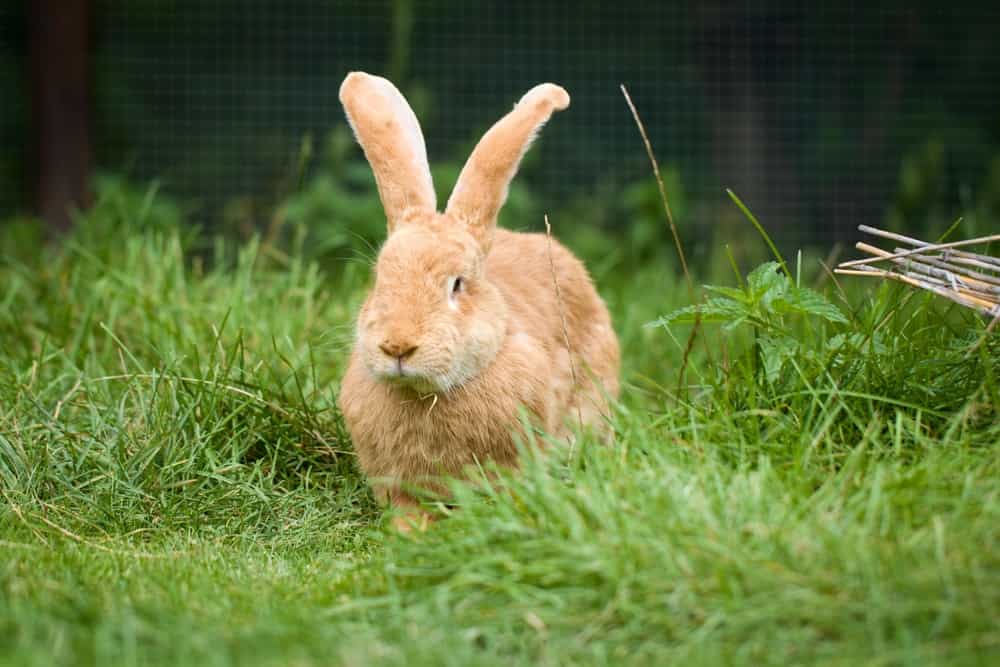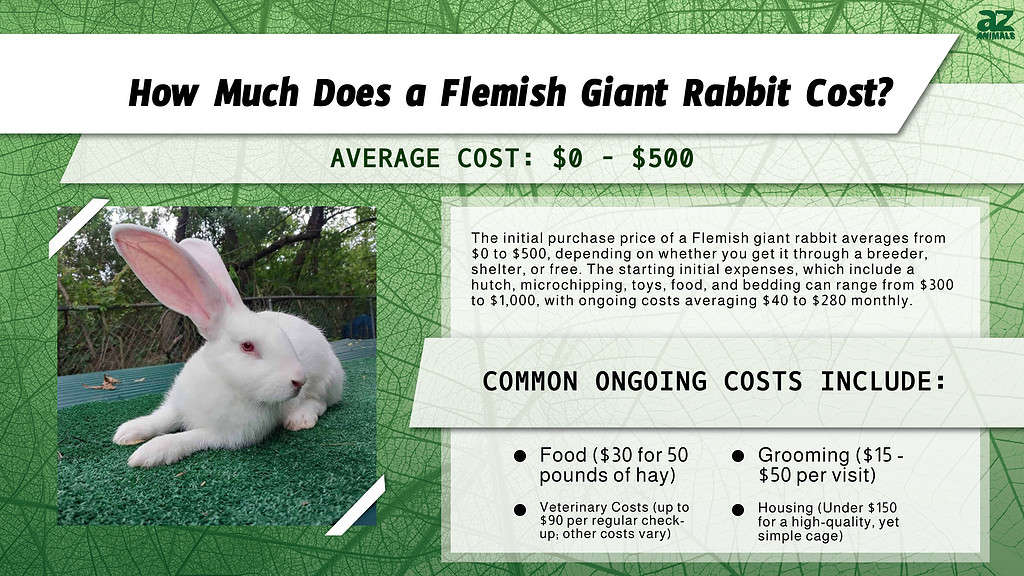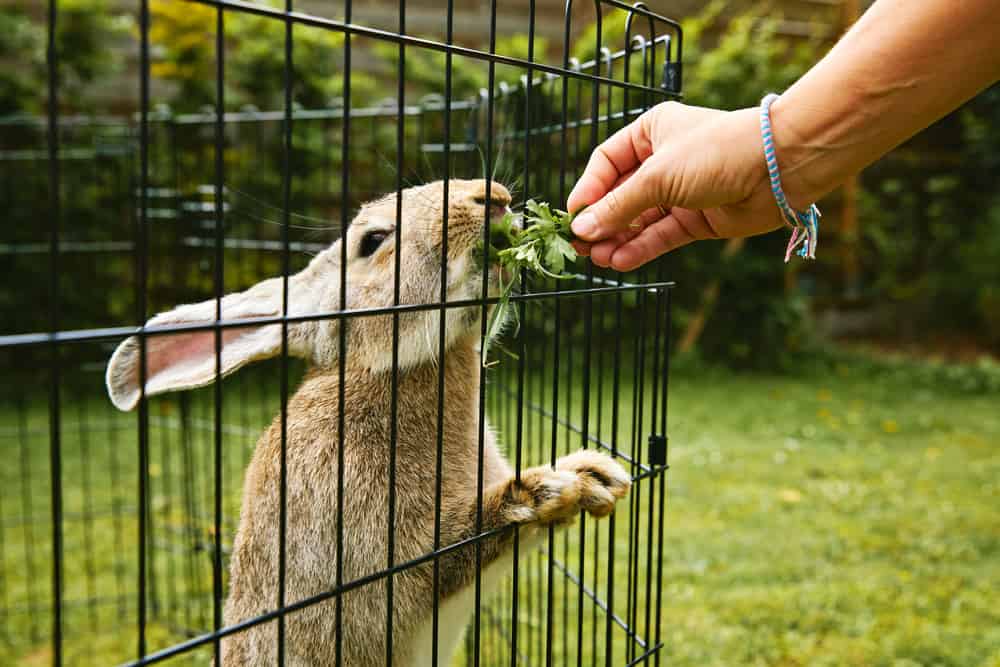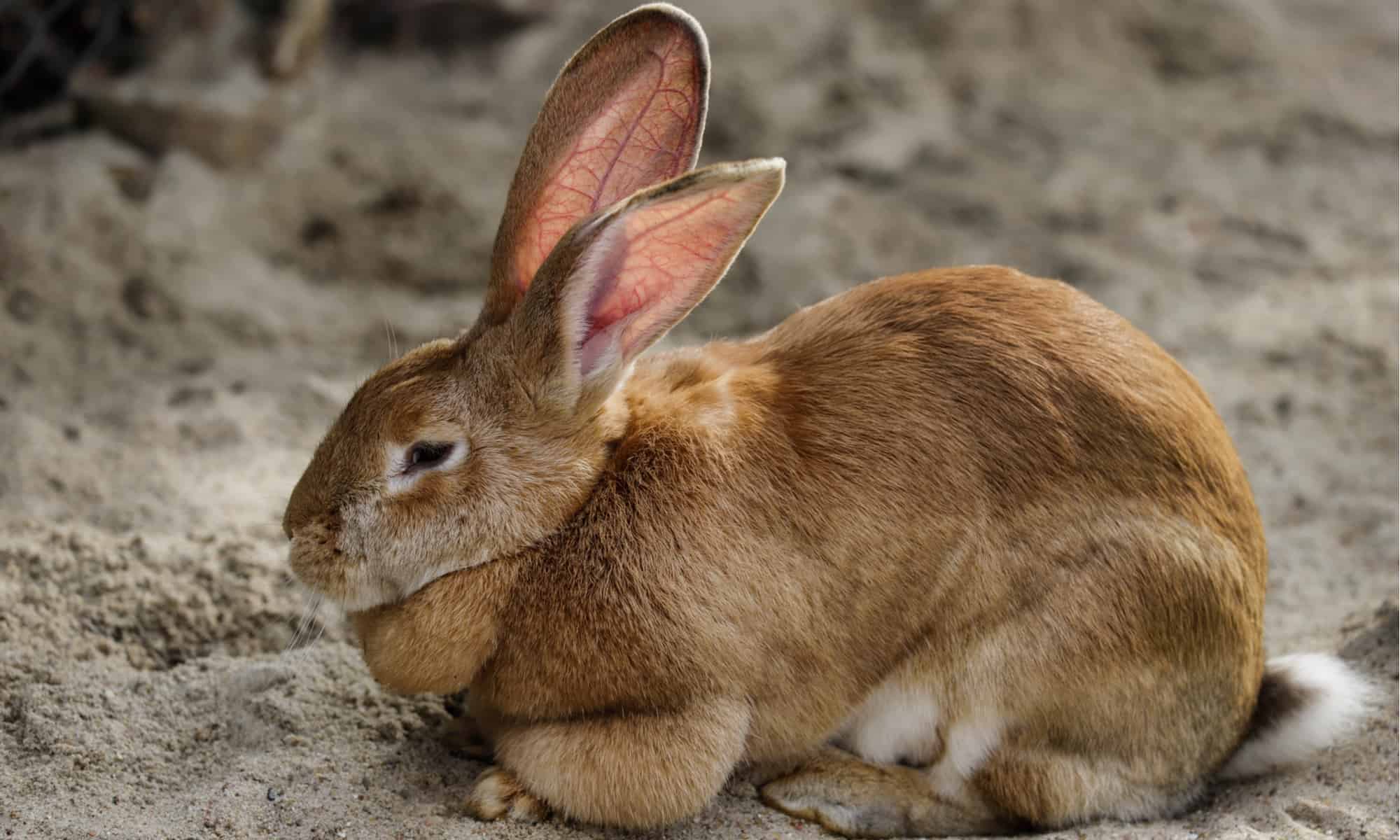A Flemish giant rabbit looks like something you might see in Alice in Wonderland. These massive rabbits make fantastic pets for all types of households. Whenever you’re considering bringing a new furry or scaly friend home, it’s essential to do your research.
Part of being a pet parent is allotting money to make sure they can live a long, happy, and healthy life. Below you will find every cost that goes into owning a Flemish giant rabbit. First, let’s talk a bit more about these incredible creatures.
What is a Flemish Giant Rabbit?

Flemish giant rabbits love playing in grass.
©Dan_Koleska/Shutterstock.com
The Flemish giant is arguably the most impressive rabbit in the world. You may initially think it was a floppy-eared puppy if you spotted one hopping in the distance. These rabbits can grow to be nearly three feet long and weigh an average of 15 pounds.
To keep their offspring warm, females have a dewlap, a large flap of skin beneath the chin. A Flemish giant should have a large, exquisitely sculpted head, prominent ears, a tall, muscular body, consistently colored fur, and a neatly contoured backside, in accordance to breed standards. The thick, lustrous fur of Flemish giants exists in a range of beautiful colors.
How Much Does a Flemish Giant Rabbit Cost?
The initial price of any pet depends on where you get it. There are free Flemish rabbits, and you also can adopt or buy from a breeder. Let’s break down the different costs associated with each option.

Free
If you’re lucky, adopting a new family member won’t cost you a dime. When people adopt a new pet, they occasionally discover later that they are unable to provide for their needs. This may lead the owner to give them away for a low amount or possibly free!
The main disadvantage of getting a Flemish giant rabbit in this manner is that there is no health assurance. It might be unwell, and the former owner is attempting to dispose of it to the next individual.
Therefore, before rescuing a rabbit, ensure its safety by finding out about the rabbit’s health. For additional piece of mind, you might request that the owner have the hare examined by a veterinarian prior and give you a copy of the documents.
Adoption
In most cases, pet shelters are a good place to look for previously owned Flemish giant rabbits. These animals had lived in a house but for a variety of reasons their previous owners were unable to carry on taking care of them.
The people who own the pets will then give these animals up to their neighborhood humane societies or animal shelters, who will handle the adoption procedure. An animal like a Flemish giant rabbit can usually be adopted from a shelter for less than $100.
Breeder
The third and last way to get a Flemish giant is by contacting a breeder. You should do some homework to make sure that you buy from a trustworthy breeder because there are plenty of them to choose from.
Your new rabbit’s final cost will be determined by its quality, pedigree, and reproductive potential. For instance, one of the most well-known Flemish giant breeders in the United States is Happy Tails Rabbitry. They divide their bunnies into the following quality categories: standard, outstanding, and superior.
The “standard” grade rabbits have mothers that weigh up to 15 pounds, whereas the “superior” level rabbits have at least one parent that weighs more than 18 pounds. The cost of purchasing one of these priceless animals from a breeder can reach $500.
Costs Associated With Owning a Flemish Giant Rabbit

Flemish giants need plenty of space to roam.
©nigel baker photography/Shutterstock.com
Now that you know how much one of these rabbits can cost you initially, what about the other things you’ll have to pay for? Here are additional costs that come with bringing home a Flemish giant rabbit.
Food
As you might have suspected from their name, Flemish giants are a bigger breed of rabbit that requires a greater amount of nourishment to maintain their well-being and stamina. This kind of rabbit, like the majority of them, should eat primarily fresh hay, pellets, and veggies.
Since they are grazing animals, they require a constant supply of fresh hay, which should make up about 80% of your pet’s diet. A single bag of hay at a farm supply store can cost around $30 for 50 pounds! Other big-name pet stores will charge that amount for a small bag, so it may get pricey.
Don’t forget to factor in the price of treats. The best treat you can give to your furry friend is fresh veggies. Never buy any food item for a rabbit that has added colored bits in the pellets or snacks.
Grooming
You won’t have to spend any money on Flemish giant maintenance if you learn how to do it at home. Since your rabbit won’t require bathing, you’ll also need a good brush, clippers for the nails, and a toothbrush.
If you choose to pamper your Flemish giant with a spa experience at a reputable groomer each month, be sure to compare groomers. They can run under 15 dollars for one visit or well over $50!
The benefit of visiting a groomer is that they may perform a scent gland washing for you and are knowledgeable about how to spot fleas and other parasites. Another thing you may want to consider is getting your rabbit vaccinated.
Toys
Like all animals, rabbits require daily mental and physical activity. By making sure your Flemish giant has many toys to choose from, you can offer them this. When provided constructive methods to engage in their natural behaviors, such as gnawing and digging, rabbits aren’t as prone to grow irritable and disruptive to their surroundings.
Having money put away to purchase new toys on a bi-monthly basis is a smart idea because your pet will get tired of its toys and ultimately have a blast destroying them.
Foraging toys are an excellent option because rabbits enjoy going on hunts. Additionally, you could save funds by making your own toys out of paper towel rolls, empty boxes, and crinkly paper.
Medical Requirements
All of the health issues that affect other breeds of rabbits frequently occur in Flemish giant rabbits as well. Gastrointestinal stasis, malocclusion, breathing disorders, mites, and uterine cancer in females who haven’t been spayed are a few of these.
In an ideal world, your pet won’t require any medication or regular trips to the doctor. However, if your pet has a condition that calls for medicine or more regular trips to the veterinarian, you’ll obviously need to account for it in your spending plan.
Although immunizing pet rabbits is not required by law, it is highly recommended to prevent your rabbit from potentially fatal infections. Maintaining your annual immunization schedule is crucial for both you and your pet.
Housing

Giving your rabbit a spare bedroom to roam instead of a cage will make them happier and healthier!
©mariesacha/Shutterstock.com
To maintain a clean environment in its cage or hutch, you must change your rabbit’s bedding on a regular basis. In their primary enclosure, particularly in the area surrounding their litter box, they require about two inches of top-notch bedding.
Using affordable fleece blankets can save you a ton when it comes to bedding. Fleece absorbs urine and is machine-washable, making it a better choice for the environment as well. Although we understand some people require a cage for these animals, due to their size, it’s best to give them a dedicated room.
If you have to get a cage, find one as large as possible. A high-quality, yet simple cage will cost you under $150. Some rabbit keepers don’t use any bedding at all outside of the litter box.
Although this is a matter of personal opinion, we advise saving money by only using the bedding in the litter box. Spending money on cleaning materials like cage deodorizers is also advisable. A single bottle will last at least a year!
Pet Insurance
As you’ve read in the medical requirements portion above, Flemish giant rabbits don’t require frequent trips to the vet unless they have a specific condition. For some pet owners, this makes pet insurance relatively pointless.
If you choose not to purchase insurance, make a monthly savings plan to pay for any unforeseen expenses. Rabbits are susceptible to a number of costly illnesses, including Pasteurella, myxomatosis, and rabbit hemorrhagic sickness.
The cost of rabbit insurance varies from one policy to another according to the level of protection and the amount of coverage that you select. A lot of insurers provide consumers the flexibility to change their deductibles and rates of reimbursement in order to identify a cost per month that fits their budget.
Option Costs to Owning a Flemish Giant Rabbit

Find a pet sitter that has experience with these enormous rabbits.
©cynoclub/Shutterstock.com
Now that you know about the base costs and the requirements involved in owning a Flemish giant rabbit, there may be optional or additional costs that come up. These may include the following.
Emergency Vet Visits
It’s impossible to predict when a crisis will arise, and the cost of emergency care, particularly for a Flemish giant can quickly mount. For this reason, a lot of pet owners purchase pet insurance. Ensure that you are saving money every paycheck in the event of an emergency if you are unable to pay for pet insurance.
Pet Sitting
If you ever need to leave your rabbit for more than a day, having a pet sitter is a must. Although you may have a selfless friend who’s willing to help out for free, sometimes you may need to hire a professional.
Luckily, Flemish giant rabbit pet sitters and caretakers are relatively affordable. You can expect to pay a maximum of $40 per day for someone to feed your pet and clean their living area. Many pet owners opt to tip a pet sitter, so consider a few extra bucks for that.
House Damage
If you’ve ever brought home a new puppy, you’ll know that they will happily chew on furniture, pee on your carpets, and rip up clothing. Without adequate mental stimulation, a restless rabbit can wreak havoc in your house.
They may dig holes in your wood flooring or carpet, nibble at the edges of walls or basements, urinate where it is unacceptable, or even chew on wiring and other electronic devices. Giving your pet ample stimulation and playing will prevent this habit from forming in the first place.
Final Thoughts
The price to bring home a Flemish giant rabbit might range from free to $500 or more. The starting initial expenses, which include a hutch, microchipping, toys, food, and bedding could be expected to range from $300 to $1,000.
The monthly spending plan could range from $40 to $280, contingent upon your shopping skills and the condition of your pet. Overall, these massive rabbits make incredible pets, have a low overall cost, and can bring plenty of love and joy into your home.
Thank you for reading! Have some feedback for us? Contact the AZ Animals editorial team.








